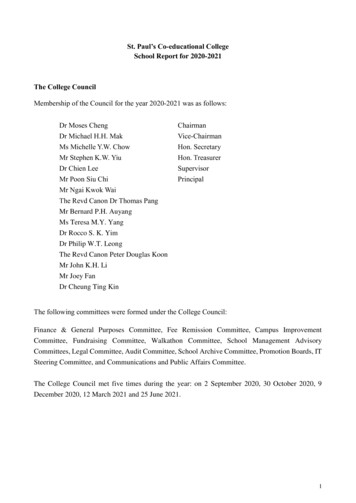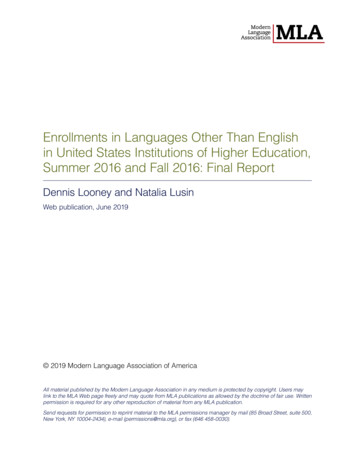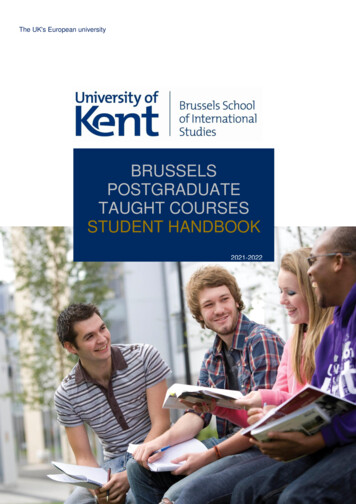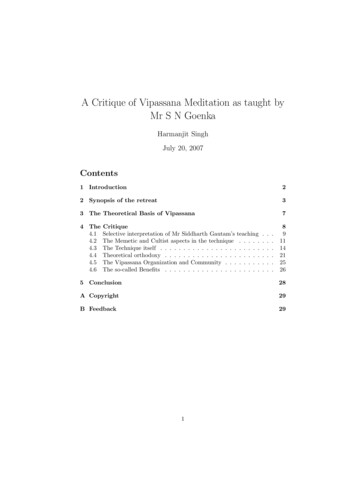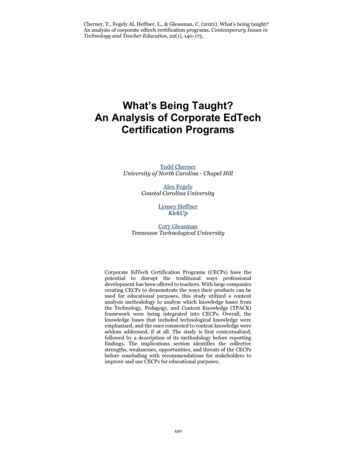
Transcription
Cherner, T., Fegely Al, Heffner, L., & Gleasman, C. (2022). What’s being taught?An analysis of corporate edtech certification programs. Contemporary Issues inTechnology and Teacher Education, 22(1), 140-175.What’s Being Taught?An Analysis of Corporate EdTechCertification ProgramsTodd ChernerUniversity of North Carolina - Chapel HillAlex FegelyCoastal Carolina UniversityLynsey HeffnerKickUpCory GleasmanTennessee Technological UniversityCorporate EdTech Certification Programs (CECPs) have thepotential to disrupt the traditional ways professionaldevelopment has been offered to teachers. With large companiescreating CECPs to demonstrate the ways their products can beused for educational purposes, this study utilized a contentanalysis methodology to analyze which knowledge bases fromthe Technology, Pedagogy, and Content Knowledge (TPACK)framework were being integrated into CECPs. Overall, theknowledge bases that included technological knowledge wereemphasized, and the ones connected to content knowledge wereseldom addressed, if at all. The study is first contextualized,followed by a description of its methodology before reportingfindings. The implications section identifies the collectivestrengths, weaknesses, opportunities, and threats of the CECPsbefore concluding with recommendations for stakeholders toimprove and use CECPs for educational purposes.140
Contemporary Issues in Technology and Teacher Education, 22(1)Large technology companies’ impact on education is unprecedented.Ranging from devices to videoconferencing applications to learningmanagement systems, these companies’ innovations impact the field ofeducation in very real ways for teachers and students alike. With educationand technology continuing to integrate, the term “edtech” has emerged asa catchall reference to the technologies being developed and used foreducational purposes (Cherner & Fegely, 2018). This term now appears ineducational policy and best teaching practices and is infused in teachereducation programs (Williamson, 2019).These technologies are not neutral, however. Companies have a profitmotive for developing and selling them (Wright & Peters, 2017), and amultibillion-dollar edtech marketplace has emerged, in which technologycompanies sell products to educational organizations (Cherner & Mitchell,2020). With their technologies being bought by schools and used byteachers and students, the technologies themselves influence the waysteaching and learning happens (Wright & Peters, 2017). Therefore, ifeducators – preservice and in-service teachers as well as teacher educators– are going to use edtech for teaching and learning, they must be aware ofthe influence of technology companies on education. They may have largerimplications for them and their students.Building educators’ awareness around the edtech they use is important.The experiences students have with technology during their compulsoryeducation can impact their preference for choosing certain technologybrands in the future (Hinchey, 2008). For example, if students completetheir secondary education primarily using Google Chromebooks that runon Google’s operating system, they may prefer to use Google productsduring their postsecondary education and then on into their professionaland private lives. In this way, the experiences students have withtechnology throughout their K12 education are formative to theirconsumer preferences later in life.To support the adoption of their products, these companies havedeveloped corporate educator certification programs (CECPs) that providefree or low-cost professional development opportunities. Teachers cancomplete these CECPs to earn certifications, digital badges, and otherprofessional marks of distinction. At a time of increasing interest in usingedtech to deliver high-quality instruction that cuts across geographic,social, and political barriers, CECPs have grown in popularity (McLeman,2016; Tittel, 2013), though a critical analysis of them has yet to beconducted. In response, this study’s research question was as follows:What types of knowledge do educators gain from completing corporateeducator certification programs?To conduct that analysis, this paper will first describe how CECPs aresituated within the edtech marketplace. Next, the theoretical frameworkand methodology used to analyze CECPs are described, followed by thestudy's findings. To conclude, recommendations for using CECPs areoffered.141
Contemporary Issues in Technology and Teacher Education, 22(1)Situating CECPs in the Edtech MarketplaceThe edtech marketplace is valuable. HolonIQ (2019) estimates that itsvalue will be 404 billion by 2025. While both scholars and professionalshave written about the edtech marketplace, Southwick’s (2021)description represents a common view when describing it as “a diverse andrapidly growing industry with a large runway across the business lifecycle,from early-stage startups to middle-market companies to publicly tradedcompanies” (para. 3), with the larger companies being Apple, Google, IBM,Lenovo, and Microsoft.Notable examples of smaller stage startups that have grown to middlemarket companies are Newsela (https://newsela.com/signin), Nearpod(https://nearpod.com/), and Hypothes.is (https://web.hypothes.is/education/). By focusing only on the companies that develop and providetechnologies, Southwick’s (2021) description overlooked other keystakeholders, such as politicians, philanthropists, activist groups, andnews media (Cherner & Mitchell, 2020; Williamson, 2021). Thesestakeholders influence the climate around edtech, which can encourage ordiscourage its adoption in schools. When edtech’s adoption is encouraged,the marketplace is further extended to include the supports educators mayneed to use edtech effectively with students.Professional development is often identified as a key component toensuring that the use of edtech is beneficial for teaching and learning(Bond et al., 2018) and not for entertainment purposes. Traditionally,professional development has been offered by school districts, atconferences, and through contracted providers, which will be discussed inthe review of literature. However, professional development in the form ofCECPs is a relatively new area, and though it has overlap with moretraditional offerings, CECPs also include a stealth marketing component(Wright & Peters, 2017).Essentially, CECPs provide educators with two benefits: (a) a pathway toearn professional credentials and (b) access to information. Depending ontheir career path and future aspirations, these credentials can be used forcareer advancement, continuing education units, annual professionalgrowth, or other kinds of distinction. The access to information provideseducators with advanced knowledge about the topics addressed in theCECP, which often focuses on the edtech provided by the company offeringthe CECP.For example, Edmodo (https://new.edmodo.com/) is a learningmanagement system used in public schools, which offers a certificateprogram for educators as its CECP. On its website, Edmodo (2020)explained that by completing its program educators earn “The Edmodo Certified Trainer digital badge: This can be sharedon your website, blog, email signature, etc.Letter of completion: This letter explains, in detail, the work youhave completed as a participant in the train the trainer course forthe ECT program142
Contemporary Issues in Technology and Teacher Education, 22(1) Certificate naming you an official ‘Edmodo Certified Trainer.’”(para. 3)For educators who are interested in using Edmodo, these credentials couldhave great appeal, as they may be useful for career advancement whileimproving their use of Edmodo’s learning management system. Yet, theCECP does not conclude with the credentials only. Rather, Edmodo hasexpectations for teachers who complete their CECP that include hosting atleast two face-to-face trainings focused on Edmodo to 10 or moreeducators annually and actively participating in its professional learningcommunity. They also expect teachers to “‘Rep’ [sic] Edmodo withprofessionalism in Edmodo groups, communities, and face-to-faceopportunities” (para. 5).In this way, Edmodo directly benefits from educators who completed itsCECP. They become its brand ambassadors, meaning that they are topromote Edmodo as part of the distinction they earned from being anEdmodo Certified Trainer. Though identifying the number of CECPs thatuse similar strategies is important, it falls outside the scope of this study.Yet, before that type of analysis can be conducted, it is important to firstevaluate shifts in professional development (PD) before evaluating theknowledge included in CECPs.A Review of Shifts in PDPD for teachers is undergoing a fundamental shift. Whereas it used to beplanned for them by school administrators, teachers are now able to seekout their own PD opportunities to address the needs of their students andimprove their own teaching practices (Hord, 2015; Lieberman & Miller,2016). Researchers have identified effective aspects of traditional PD (e.g.,providing hands-on learning opportunities and aligning PD withclassroom context; Yoon et al., 2020). They have also found teachersdescribing traditional PD as being shallow, rigid, top-down instructionproduced by outsiders that is irrelevant to them and their students(Darling-Hammond et al., 2017; Darling-Hammond & Richardson, 2009).Regarding PD, in general, researchers have found that it often has littleimpact on teachers’ practices (Darling-Hammond et al., 2017; Desimone& Garet, 2015), which can result in teachers viewing PD as being a requiredmandate to complete instead of an opportunity for professional growth(Bill & Melinda Gates Foundation, 2014). Merritt (2016) added thatteachers have little time for PD, and she found that they wanted moreaccess to PD, with a specific interest in materials and strategies forimproving their instruction.Peltola et al. (2017) added that additional on-demand access to PDremoves time constraints, which they found acted as barriers to PD andbetter supported their face-to-face instruction. Outside of access, Porter etal. (2000) found that teachers are more invested in PD when they have theability to choose topics aligned to their values and goals. Supporting thisidea, research by Al-Bargi (2021) detailed teachers’ preferences to either“be given the opportunity to select from a variety of sessions [or] begiven the opportunity to send their own desired choice” of PD session143
Contemporary Issues in Technology and Teacher Education, 22(1)recommendations to the administrators to help address their specificneeds with online teaching (p. 1167).The literature has documented examples of online PD successes. An(2018) studied the impacts of an online PD and found significant increasesfrom the presurvey to postsurvey in the teachers’ understanding thatgames have educational benefits for students and the potential to develop“real-world skills” in students. Parson et al. (2019) found that when PD isoffered online, over 83% of teachers indicated that it was eithermoderately or extremely beneficial to their teaching practice, and 90% ofthose teachers responded that the availability of online resources waseither very or extremely important.When offered online, the outcome of those PD sessions resulted inincreased levels of student achievement and behavior, which werecomparable to in-person PD offerings (Fishman et al., 2013, Webb et al.,2017). In fact, a study conducted by Grunwald Associates LLC and DigitalPromise (2015) found that 72% of teachers surveyed independentlylearned from expert videos, online learning communities, and socialmedia because they felt the need to stay current and enjoyed learning.Other researchers identified that earning certificates and digital badgeswere motivating factors for teachers if they were aligned to their classroomcontext (Beach, 2017; Singer, 2017).While research on the topic of online PD during the COVID-19 pandemicis still emerging, Hartshorne et al. (2020) said, “There will be tremendousvalue in research published after the pandemic that looks back to find outwhat worked, what did not work, and what could be learned to improvecurrent and future practice” (p. 138). From the research that has beenpublished, Poce et al. (2021) found that online PD webinars were morelikely to be attended by those who had preexisting comfort with e-learning,and Safi et al. (2020) found that self-directed, unstructured PD learningcommunities where teachers could share resources and pedagogicalpractices were useful for supporting those teachers implementing remoteteaching. Cavanaugh and DeWeese (2020) found that teachers had apreference for PD resources in asynchronous video formats whensearching for online teaching pedagogical resources. Overall, online PDhas increased in popularity, and the adoption of edtech by schools hasimpacted the topics addressed by PD.A Focus on EdTechEdtech’s roles in schools continues to expand, and teachers have requestedPD about edtech that includes strategies for utilizing it for instructionalpurposes (Hall & Martin, 2008) along with best practices for integrating itinto their planning processes (Bettis, 2015). To support their learning,Hew and Brush (2007) suggested that PD focused on edtech for teachersshould address (a) teachers’ technology knowledge and skills, (b) activelearning strategies for using edtech, and (c) ensuring edtech’s relevance totheir immediate classroom needs. In addition, Kelley (2019) explainedthat PD focused on technology should emphasize the connections betweenpedagogy, content, and technology concepts.144
Contemporary Issues in Technology and Teacher Education, 22(1)In summary, researchers have identified multiple elements of effective PD,such as accessibility of materials, availability of content, and relevance totheir contexts. In response, PD as a form of credentialing has becomevalued by teachers.Certificate Programs in EducationIn the context of PD, Besser and Newby (2020) explained that an emergingtrend in education is “validating and credentialing learning taking placeoutside of traditional academic settings'' (p. 79), which is called alternativecredentialing. Though it is not new, alternative credentialing was first putforward in the early 1980s as a path for providing teachers PDopportunities (Green, 1980, as cited in Grant, 2016). In more recent times,alternative credentialing has taken the form of microcredentials thatDeMonte (2017) described as “an approach to professional learning thatprovides teachers with the opportunity to learn and demonstratecompetency in new skills, while also getting feedback from an outsideevaluator and earning recognition for mastery by earning the microcredential” (para. 1).Once earned, teachers looking for a new position can includemicrocredentials on their resumes and professional portfolios as well as intheir email signatures and their social media profiles (Besser & Newby,2020). As researchers have found that educator preparation programs donot fully prepare preservice teachers for the classroom (Lampert, 2012;Zeichner, 2012), some schools have incentivized teachers earning thesecredentials in specific areas (Abramovich, 2016), and organizationsincluding the National Educators Association (2021) offer microcredentialing opportunities to teachers. As a result, microcredentials arebecoming a viable alternative to more traditional PD, but they are notwithout critique.Critiques of Microcredentialing in the Form of CECPsCECPs are a form of microcredentialing for teachers that have grown inpopularity (Gamrat et al., 2014; Law, 2015). Kelley (2019) explainedCECPs as “A unique phenomenon occurring in education where largetechnology companies or vendors such as Apple, Google, and Microsoft arerecruiting educators to participate in professional development programsdesigned to promote technology integration in their practice” (p. 1), and atthe surface level, these CECPs appear to be partnering with educationalentities to teach edtech-driven pedagogy (Apple, 2018; Google, 2018;Microsoft, 2018).Carey and Stephaniak (2018) noted a debate within the educationcommunity as to the effectiveness of CECPs as PD due to the lack ofresearch on their quality and design. Gras and Kitson (2021) said thatonline teacher certification programs often are incomplete and general,based on the time needed to complete them. Croninger et al. (2007)pointed out that alternative credentialing may lack research-basedpedagogical best practices in the name of brevity.145
Contemporary Issues in Technology and Teacher Education, 22(1)Kelley (2019) added that, while technology companies may supportteacher and student learning, they have a dual aim of promoting theirproducts with schools. In response, Boninger et al. (2017) and Gregory(2017) called for the decoupling of technology companies and educationalinstitutions. Specifically, Boninger et al. were concerned about stealthmarketing elements embedded within CECPs that promote a company’sproducts instead of high-quality pedagogy. Similarly, Gregory pointed outthat curricula from for-profit educational entities in the form of CECPsmay be informed by business interests, not research.In summary, the shift in teacher preferences for PD has given rise tomicrocredentialing programs. While valuable, researchers found thattechnology companies have identified microcredentialing programs as apotential channel to promote their products in schools under the guise ofPD, which has caused concern. To examine that concern, this studyutilized the technological pedagogical content knowledge framework toanalyze the actual knowledge bases emphasized by CECPs.Using TPACK as a Framework forAnalyzing Knowledge BasesThe technological, pedagogical, and content knowledge (TPACK)framework (Koehler & Mishra, 2009; Mishra & Koehler, 2006) identifiesthe interconnectedness of three core knowledge bases teachers need fordelivering instruction in the digital age. Previous to TPACK, Shulman(1986, 1987) argued that teachers need deep knowledge about the contentthey teach, along with effective strategies for engaging students in thatcontent.As schools adopted digital technologies, Mishra and Koehler (2006) wereamong those who identified the need for teachers also to have deepknowledge about technology for effectively integrating technology forinstructional purposes, which was later labeled TPACK. As shown inFigure 1, TPACK is represented as a three-bubble Venn diagram, with eachbubble representing a specific knowledge base.The technological knowledge base represents educators’ abilities to selectand use digital tools and devices in the classroom. The pedagogicalknowledge base is their abilities to plan and utilize instructional strategiesto engage students in learning, and the content knowledge base is theirdeep understanding of the subject matter they teach. The areas of overlapsymbolize where two or more knowledge bases combine, creating uniqueareas of emphasis.For instance, the overlap between pedagogical knowledge and technologyknowledge is technological pedagogical knowledge, which is the use ofdifferent digital tools for teaching and learning. Graham et al. (2009)explained that TPACK is achieved when a “teacher knows howtechnological tools transform pedagogical strategies and contentrepresentations for teaching particular topics and how technology toolsand representations impact a student’s understanding of these topics” (p.71).146
Contemporary Issues in Technology and Teacher Education, 22(1)Figure 1Revised Version of the TPACK image. Punya Mishra, 2018.Reproduced with permission.TPACK’s final element is the dashed segments that form a circle aroundthe Venn diagram, and it represents educators’ contextualized knowledge,which includes a teacher’s knowledge of available technologies, access tothose technologies, and possible challenges about using them, amongother factors (Mishra, 2019). This contextualized knowledge is importantbecause, for example, teachers at a school with access to advancedtechnologies, such as virtual reality, need TPACK differently than at aschool where teachers and students share class sets of tablets.With its well-defined knowledge bases, researchers have adopted TPACKto analyze different types of content. For example, Koushki et al. (2020)employed a statistically validated checklist based on TPACK’s knowledgebases to analyze a syllabus used in information technology courses. Fromtheir analysis, Koushik et al. determined that technological contentknowledge was the base most frequently addressed by the syllabus, andtechnological knowledge was the base least addressed. The implicationswere that the syllabus emphasized how to use technology for locatingcontent, but not how to use the actual technology.In another study, Zhang et al. (2019) analyzed the discourse of 934teachers taking an online PD. To analyze the discourse, the researchersdeveloped a coding scheme that operationalized each of TPACK’s innerknowledge bases based on the context of the PD, and it included examplesof ways a knowledge base could be expressed. For example, theyoperationalized technological knowledge as “Knowledge of using147
Contemporary Issues in Technology and Teacher Education, 22(1)emerging technologies” (p. 3443), and the example they provided was,“Teachers can use special functions in electronic whiteboards, such as thespotlights, to highlight important teaching content” (p. 3343). Using thiscoding scheme, they identified the preponderance of comments focusedon pedagogical content knowledge (53.5%). Next were pedagogicalknowledge (15.5%) and technological pedagogical content knowledge(15.3%). None of the other knowledge bases eclipsed more than 6.5%.They also found that younger teachers more often provide discourseconnected to the pedagogical knowledge and pedagogical contentknowledge bases, while the older teachers’ discourse was more distributedacross the content knowledge, pedagogical content knowledge, andtechnological knowledge. Their conclusions were that the facilitators of thePD should offer more support to the younger teachers about theknowledge bases that went unaddressed. In summary, the works ofKoushki et al. (2020) and Zhang et al. (2019) demonstrate waysresearchers have used TPACK for content analysis, and this current studycontinued the application of TPACK for that purpose.MethodologyThis study used a deductive approach to qualitative content analysis as itsresearch methodology for identifying the types of knowledge taught byCECPs. In brief, qualitative content analysis is a process where researchersclassify nonnumerical data into categories and then look across theirclassifications to identify patterns and themes in the data (Neuendorf &Kumar, 2015; Stemler, 2015). A deductive approach draws from previousresearch and theories to serve as the foundation for the categories neededto classify data (Zhang & Wildemuth, 2009; Zhang et al., 2019). Forexample, Zhang et al.’s study analyzed data in the form of teachers’discourse collected from a PD and classified it based on TPACK’sknowledge bases demonstrates this approach. The current study wassimilar in that it focused on a PD for teachers and analyzed it usingTPACK’s knowledge bases. It differed in that the PD took the form ofCECPs and its focus was on the actual information from those CECPs, notthe teachers’ discourse.Researchers’ Positionality StatementQualitative research commonly positions researchers as being a tool forresearch (Coffey & Atkinson, 1996; Merriam & Grenier, 2019), meaningthat the researchers’ own positionalities – identities, backgroundknowledge, and beliefs – inform their interpretation of the data. Whileremoving the researchers’ positionalities is not possible in the context ofqualitative data analysis, researchers can disclose their positionalities asrelated to the topic, so readers will have a deeper understanding of howthe researchers interpreted the data and came to their findings.In the context of this study, the researchers all have classroom teachingexperience in K-12 settings and hold terminal degrees in educationgranted from an accredited institution in the southern United States. Theirinterest in this study is situated in the intersection of technology and PD,as they all agree that technology’s role in education will continue to grow148
Contemporary Issues in Technology and Teacher Education, 22(1)well into the foreseeable future and that it can be an effective tool forteaching and learning. In reflection, they have each experienced both highquality and low-quality PD sessions, and they share an interest in PDtaking the form of CECPs, along with the implications that can arise fromthe corporatization of PD. The following bullets describe the researchersand their individual interests in this study: Todd directs a graduate program focused on educationalinnovation, and he deeply believes that PD is most relevant toeducators when it provides them an experience with a tool orstrategy that they can integrate into their teaching practice.Alex is an assistant professor and prepares preservice teachersfor K-12 classrooms. Alex sees PD as being valuable when italigns to teachers’ contexts and can improve teachers’ selfefficacy and effectiveness with new tools or strategies in theclassroom.Lynsey is an industry-based researcher with a company that usesdata analytics to evaluate the effectiveness of PD. Lynsey has akeen interest in using data to evidence the impact of PD onteachers’ performance in the classroom and help school districtstake action to provide personalized professional learningopportunities that are relevant to teachers’ needs.Cory is an assistant professor, and he focuses on science,technology, engineering, and mathematics education. From hisperspective, PD must provide useful information to teachers thatthey can implement in their classroom for him to consider thePD as being effective.Our collective hopes are that this study will inform both how companiescreate CECPs and the ways K-12 schools and educator preparationprograms use them.Data CollectionWith the study’s focus being PD offerings for teachers in the form ofCECPs, we were intentional in selecting well-known educator certificationprograms. To locate them, we first entered keyword combinations,consisting of educator certification program, technology, and corporate,into multiple search engines including Google, Bing, and DuckDuckGo.We were purposeful in selecting these search engines, as Google and Bingare the two most popular search engines in the world, with Google having86.6% market share and Bing having 6.7% of it (Statista, 2021).In response to the query, the search engines largely reported results formore traditional educator preparation programs offered by universities,with an emphasis on graduate programs focusing on instructionaltechnology and school administration, along with a limited number ofinitial teacher licensure programs. Because this study was focused onCECPs, we added the names of the largest 10 technology companies in theUnited States based on their brand value (Wood, 2020), so their searchwould be better aligned to the study’s focus and research questions. The10 largest companies included Apple, Microsoft, Google, Facebook, IBM,Instagram, Accenture, Intel, Adobe, and Salesforce. Of them, only Apple,149
Contemporary Issues in Technology and Teacher Education, 22(1)Google, and Microsoft offered a CECP that was designed for K-12 teachers.Next, as each of the CECPs offered by these companies included multiplecourses, we chose to focus on the introductory or foundations coursesbecause they represented a “starting point” for the larger CECP. Thespecific courses analyzed were: Apple: Learn Skills for Mac (Apple Teacher, 2020)Google: Fundamentals Training (Google for Education, 2020)Microsoft: Hybrid Learning: A New Model for the Future ofLearning (Microsoft, 2020)This decision was made to help bound the data based on that commonality.With the data identified, we next developed a coding scheme to analyze theCECPs.Data AnalysisWhen conducting a deductive content analysis, Zhang and Wildemuth(2009) recommended developing a coding scheme, which is an instrumentresearchers will use to classify the data. When creating it, researchers mustdevelop operationalized categories based on the research and theory theywill use. The operationalized indicators in the coding scheme must be clearand precise to improve the validity. In this study, we adopted TPACK’sknowledge bases and operationalized them by paraphrasing or directlyquoting from previously published research and theories about TPACK tocreate a coding scheme. Table 1 shows the indicator for pedagogicalknowledge as an example.Table 1Representative Example of the Coding Scheme’s Dimension forPedagogical KnowledgeCategoryDefinitionPedagogical Knowledge“The teacher’s knowledge of and skill inthe use of teaching methods and otherpedagogical strategies that are not subjectspecific” (Gudmundsdottir, 1987, abs.)Yes NoIf yes, please provide an example:PedagogicalTechnologicalKnowledgeUsing technology in non-subject-specificways to facilitate learning (Koehler &Mishra, 2009)Yes NoIf yes, please provide an example:In this indicator, we operationalized TPACK’s pedagogical knowledgedimension by quoting Gudmundsdottir (1987) because this research wasformative to that knowledge base, which served as a foundation forTPACK. Next, we paraphrased Koehler and Mishra’s (2009) seminal150
Contemporary Issues in Technology and Teacher Education, 22(1)article about TPACK for the pedagogical technological knowledge base.For each knowledge base, we also created a row where we could bold the“Yes” to indicate if the data did align to the knowledge base or “No” if itdid not align. When “Yes” was bolded, we agreed to include an example ofwhere and ho
Certificate naming you an official 'Edmodo Certified Trainer.'" (para. 3) For educators who are interested in using Edmodo, these credentials could have great appeal, as they may be useful for career advancement while improving their use of Edmodo's learning management system. Yet, the CECP does not conclude with the credentials only.

